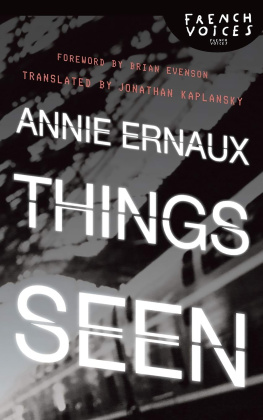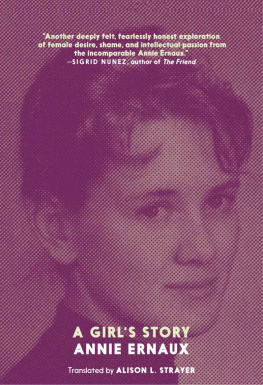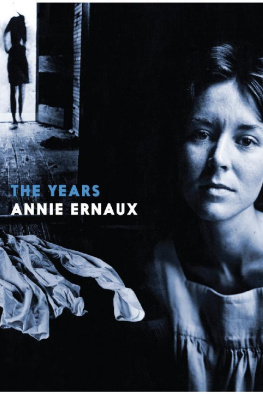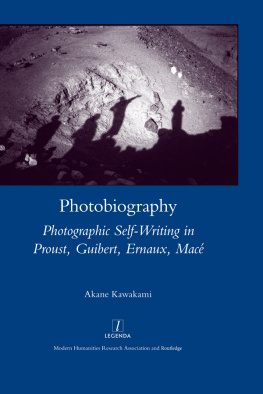Annie Ernaux - Things Seen
Here you can read online Annie Ernaux - Things Seen full text of the book (entire story) in english for free. Download pdf and epub, get meaning, cover and reviews about this ebook. year: 2010, publisher: University of Nebraska Press, genre: Art. Description of the work, (preface) as well as reviews are available. Best literature library LitArk.com created for fans of good reading and offers a wide selection of genres:
Romance novel
Science fiction
Adventure
Detective
Science
History
Home and family
Prose
Art
Politics
Computer
Non-fiction
Religion
Business
Children
Humor
Choose a favorite category and find really read worthwhile books. Enjoy immersion in the world of imagination, feel the emotions of the characters or learn something new for yourself, make an fascinating discovery.
- Book:Things Seen
- Author:
- Publisher:University of Nebraska Press
- Genre:
- Year:2010
- Rating:5 / 5
- Favourites:Add to favourites
- Your mark:
- 100
- 1
- 2
- 3
- 4
- 5
Things Seen: summary, description and annotation
We offer to read an annotation, description, summary or preface (depends on what the author of the book "Things Seen" wrote himself). If you haven't found the necessary information about the book — write in the comments, we will try to find it.
Things Seen — read online for free the complete book (whole text) full work
Below is the text of the book, divided by pages. System saving the place of the last page read, allows you to conveniently read the book "Things Seen" online for free, without having to search again every time where you left off. Put a bookmark, and you can go to the page where you finished reading at any time.
Font size:
Interval:
Bookmark:
THINGS SEEN
Annie Ernaux
Translated by Jonathan Kaplansky
Foreword by Brian Evenson
University of Nebraska Press Lincoln and London
Foreword and translation 2010 by the Board of Regents of the University of Nebraska Originally published in French as La vic extrieure Editions Gallimard, Paris, 2000.
French Voices Logo designed by Serge Bloch.
All rights reserved Manufactured in the LTnited States of America
Cet ouvrage, publi dans le cadre dun programme daide la publication, bnficie du soutien financier du ministre des Affaires trangres, du Service culturel de lambassade de France aux Etats-Unis, ainsi que de lappui de face (French American Cultural Exchange).
This work, published as part of a program providing publication assistance, received financial support from the French Ministry of Foreign Affairs, the Cultural Services of the French Embassy in the United States and face (French American Cultural Exchange).
Library of Congress Catalogingin-Publication Data
Emaux, Annie, 1940- [Vie extrieure. English] Tilings seen / Annie Emaux; translated by Jonathan Kaplansky; foreword by Brian Evenson, p. cm.
ISBN 978-0-8032-1077-6 (cloth alk. paper) isbn 978-0-80322815-3 (pbk.: alk. paper)
1. Emaux, Annie, 194cDiaries. 2. Authors, French20th centuryDiaries. I. Kaplansky, Jonathan, i960- II. Tide.
PQ266$.r67Z4 2010 848 9I4O3-dC22 IB]
2009028006
Set in Galliard by Kim Essman. Designed by Nathan Putens.
Brian Evenson
Annie Ernaux is best known for having few compunctions about mining her own life and the lives of those close to her to create work with one foot seemingly in fiction and the other in memoir. In unembellished but precise prose she examines this personal territory with care, detachment, and candor. Her first novel, Cleaned Out (1974), tells the story of a young woman who has just had an abortion and who begins painfully to reexamine her life a subject Ernaux returns to (in a less fictionalized form) in Happening (2000). In A Mans Place (1984) and a Womans Story (1987) she explores the lives of the conservative parents she has distanced herself from. I Remain in Darkness (1997) explores her mothers descent into dementia. Simple Passion (1991) chronicles a womans love affair with a man only identified as A. A later book, Se Perdrc [To Lose Oneself] (2001), takes the same subject up again in journal form, though A. has been replaced by S. In other books Ernaux explores childhood memories, the experience of becoming a woman and having children, and her struggle against breast cancer.
The intimacy of her subject matter, the unwavering objectivity with which she presents it, and the way she blurs tire line between the fictional and the real are what give Ernauxs work its strength It is quietly detached and quite unflinchingly and candidly honest. Her prose makes little attempt to provide an alibi or justification cither for her characters or for herself. Instead, she attempts to capture as nakedly as possible what it means to be a woman from a certain background who has made certain choices. She is interested in doing this not in the abstract but in particular, both in how choices large and small can form one person and how to convey all the minutiae of that persons life, all the objects and disjecta that envelop it, in a way that will resonate for others.
Things Seen was published in France in 2000 as La vie exteriure, a title that might be translated as Exterior Life or The Life Outside. It is a loose collection of jottings that Ernaux, or her narrator (the I is never named and a deliberate ambiguity remains it is cither Ernaux or a woman very much like her), makes about the world around her. The narrator offers us fleeting moments of her impressions and preoccupations, things experienced on the train or in the supermarket, things heard on the radio, things seen on tv. Presented as a i journal, on one level the book seems deeply personal.
However, most of the details Ernaux records are highly impersonal; as the French title suggests, they are scenes from exterior life, things that might happen to anyone, things that come by chance, encountered and quickly forgotten: a tramp trying to sell newspapers; the way someone looks on a subway platform; minor events while in line at a store; a fire in a subway tunnel; images of war on television.
In Se Perdre, as she recounts the details of her love affair, Ernaux admits, Le monde extrieur est presque totalement absent de ces pages (The outside world is nearly completely absent from these pages). Things Seen, however, presents just the opposite: the outside world is nearly all there is. At the same time, everything about this outside world is selected by and processed through one person, one writer. Despite her reticence, an image of her begins to form according to what she notices, and the original but eccentric way in which she renders the world. (Who else, for instance, would compare a mans amputated leg stumps to the tips of two huge penises?) By refusing to give readers the character and plot markers they usually hold onto, Things Seen becomes profoundly bound up in perception and develops a subtle contact with one persons embodied vision of the transient world.
Like many of Ernauxs books, Things Seen returns to a territory she has already touched upon in this case, to the earlier Journal du dehors [Journal of the Outside], published in 1993 and translated into English as Exteriors. Exteriors explores Ernauxs interactions with the exterior world of life in a new town located forty kilometers outside Pans, between 1985 and 1992. It shows glimpses of encounters on the metro, on the train, in stores, etc., as she explores a life she feels both alienated from and drawn to. Unlike Things Seen, in which every entry is dated. Exteriors simply organizes entries bv year. Lengths vary dramatically, ranging from nearly a third of the total book for 1986. to a mere two pages for 1990. The seven total chapters of Things Seen are a little more regular, with the shortest accounting for a fourteenth of die book and the longest (the first chapter) one quarter of the whole. Generally speaking, in the earlier Exteriors there is a higher level of uncertainty7 and discomfort both in terms of die life described and formally, as well as some commentary7 on the form itself. Indeed, tyvo-thirds of the way through the book the narrator describes herself as traverse par les gens, leur existence, comme une putain (passed through by people, by their existence, like a whore). Two thirds of the way through Things Seen, that books narrator feels quite differendy: For the first time I have taken possession of space that I have been traveling through for twenty years.
Emaux (or her doppleganger) is not the focus of Things Seen, but yve nonetheless see little glimpses of the author intimations of her history, her life. A couple hugging and kissing remind her of F. whom she hugged and kissed at the same spot, though we learn nothing more about F. than this. She walks down a I street and remembers she walked down it on another occasion to go see Doctor M though she does not say why she was seeing the doctor. She mentions a we going to a political demonstration, but who the other part of that we is she never says. They visit her, they watch X-Files and play video games, and she does two loads of his laundry. When she finally does identify them, she does so in an impersonal way, as if they are not connected to her at all: nothing personal: the Sunday of a single woman whose son comes to see her with his girlfriend, in the Paris area.
There are also a few pseudo-personal moments: a film is described in such a way that at first the reader doesnt know its a film (as opposed to something being directly experienced). Indeed, the narrator often seems as affected by what she experiences through film or television as she does by the real events of her life. One of the major tensions of the book is the friction between news from afar and the substance of the day-to-day life around us. We can feel concerned about Princess Dianas death because it requires nothing from us except tears for the injustice of destiny. It consoles. It doesnt importune us in the same way the homeless woman at the bottom of the metro stairs does. Nor, on the other hand, does it make us ashamed of doing nothing as a war broadcast might.
Font size:
Interval:
Bookmark:
Similar books «Things Seen»
Look at similar books to Things Seen. We have selected literature similar in name and meaning in the hope of providing readers with more options to find new, interesting, not yet read works.
Discussion, reviews of the book Things Seen and just readers' own opinions. Leave your comments, write what you think about the work, its meaning or the main characters. Specify what exactly you liked and what you didn't like, and why you think so.






